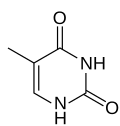Thymine facts for kids
| Thymine | |
|---|---|
 |
|
| IUPAC name | 5-Methylpyrimidine-2,4(1H,3H)-dione |
| Identifiers | |
| CAS number | |
| MeSH | |
| SMILES | CC1=CNC(=O)NC1=O |
| Except where noted otherwise, data are given for materials in their standard state (at 25 °C, 100 kPa) Infobox disclaimer and references |
|
Thymine is a special chemical building block. It is one of the four main "letters" that make up DNA, which is like the instruction manual for your body.
What is Thymine?
Thymine is also known as 5-methyluracil. It belongs to a group of chemicals called pyrimidine bases. Think of it as one of the essential pieces needed to build the amazing molecule called DNA.
Thymine's Role in DNA
In DNA, thymine is always represented by the letter "T". It has a very important job: it always connects with another building block called adenine (A). These two "letters," T and A, form a pair.
These pairs are held together by weak chemical connections called hydrogen bonds. These connections are like tiny invisible magnets. They help hold the two long strands of the DNA molecule together. DNA looks like a twisted ladder, and these T-A pairs form the rungs of that ladder.
Thymine and RNA
Sometimes, your body needs to make a copy of a part of the DNA instructions. This copy is called RNA. In RNA, thymine (T) is not used. Instead, another similar building block called uracil takes its place. Uracil does the same job as thymine in RNA, helping to carry the genetic information.
See also
 In Spanish: Timina para niños
In Spanish: Timina para niños

